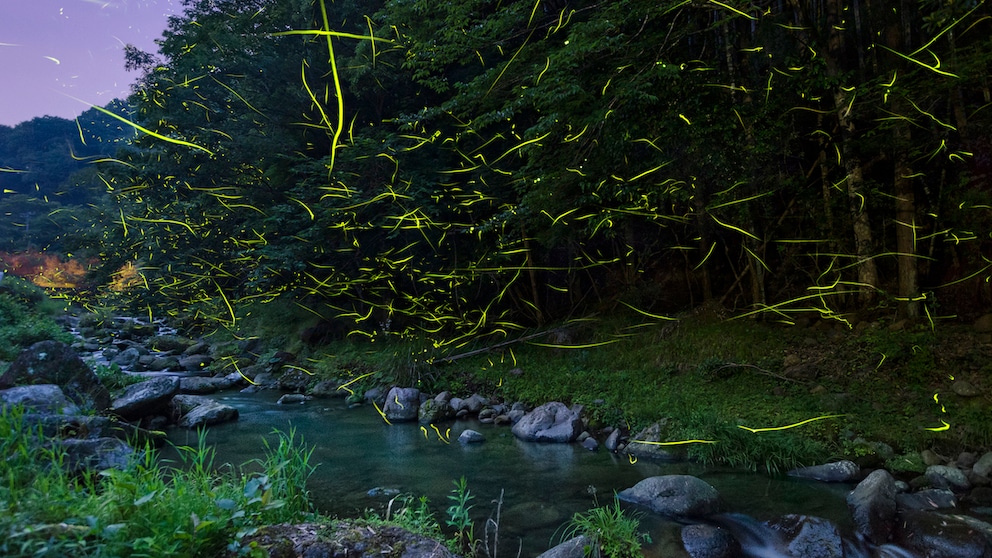June 23, 2024, 11:43 am | Read time: 4 minutes
At the end of June every year, there is a great nocturnal spectacle provided by fireflies. The glowing beetles, however, can only be observed at certain times and in certain regions. If you live in a big city, the likelihood of seeing one is almost zero. PETBOOK reveals where in Germany you can find the fireflies.
It must be an incredible sight to see hundreds of greenish, glowing flashes of light floating through the air like little elves. Those who live in the city, however, will probably miss out on this spectacle. Densely populated areas simply do not provide the correct habitat for these insects. The firefly is not considered a worm but rather a beetle, scientifically known as the Lampyridae group. There are around 2000 species worldwide. Three of them are found in Central Europe and, therefore, also in Germany. In the following article, you can find out which species they are and where you are most likely to see these glowing insects.
Why do fireflies glow?
Fireflies emit glow signals mainly to find a partner, but also to communicate with each other. The glow is caused by a biochemical reaction in the abdomen of the insect. Which means it is not the whole beetle that glows, but only its elongated abdomen, which is probably why they look like a glowing worm. However, not all of the 2000 firefly species can produce light. In some species, for example, only the females have luminous organs; in others, both sexes do..1
The signals themselves also vary from species to species. Some emit flashing signals, while others produce a continuous glow. There are also fireflies that make use of the light signals of other species. Females of the genus Photuris imitate the flashing signals of females of another genus in order to attract their mates. Not to seduce them, but to eat them.
What types of fireflies are there in Germany?
There are three species of fireflies in the German regions:
- Small firefly (Lamprohiza splendidula), also known as the common firefly, St. John’s beetle, or St. John’s worm
- Large firefly (Lampyris noctiluca), also known as the large glowworm or the large St. John’s firefly.
- Short-winged firefly (Phosphaenus hemipterus)
Firefly females have no wings. So if you see it glowing on bushes, leaves or in meadows, it is most likely a female. If the lights float through the air, they are males of the small firefly or the short-winged firefly, as the males of the large firefly do not have functioning light organs.

When and where can you see fireflies?
Fireflies are on the move from June to August. However, they are said to be most visible around June 24, St. John’s Day. This is why the insects are also called St. John’s bugs in some regions. The insects are probably hardly noticeable during the day. The magic only begins at nightfall and lasts until around midnight.2
Fireflies are said to be particularly common on forest edges, in meadows, and bushes, or near ponds and riverbanks. Fireflies are particularly active on warm and windless evenings. They avoid brightness. So it’s no wonder that you never see them in big cities. However, if you live in the countryside or in areas with little light pollution, you would even be able to lure them into your own garden. Read MyHOMEBOOK to find out how.
It is often said that fireflies can mainly be found in southern Germany. The truth is, they can actually be found all over Germany. On his website, amateur entomologist René Spierling collects information on where fireflies are spotted in Germany. The map on his website shows that many fireflies are spotted in southwest Germany in particular, but also in central Germany and even just outside the capital. So as a Berlin city kid, I might still have the chance to witness the magic of the glow without having to drive across the country.

Biological phenomenon From 6 to 900! How bats get their heart rate up to full speed

Native Songbirds Interesting Facts About Chickadees That You Didn’t Know Yet

Ornithologist Explains The Nuthatch — European Native Wild Bird and Climbing Artist
Are fireflies endangered?
As early as 2020, US researchers at Tufts University in Massachusetts warned of the loss of firefly habitats..3 The main reasons for this are the dwindling habitats of these insects and the intensification of agriculture. Increasing light pollution also certainly plays a role, as fireflies need darkness to find their mates. For this reason, male fireflies avoid light.
Even weak light sources can disrupt the mating behavior of fireflies. Researchers from the British University of Sussex found that at the weakest level of white light, only 70 percent of male fireflies of the species Lampyris noctiluca were able to find the glow of females. In the brightest light, the figure was only 21 percent..4

